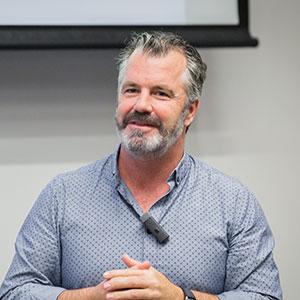CIO50 2020 #24: Jason Mangan, University of Auckland

“Move fast, but don’t lose control of the narrative, and take care of the ‘long tail’.”
This is the key lesson for Jason Mangan as he leads through an ongoing business transformation programme as chief technology officer at the University of Auckland.
“This ensures you get the maximum return on your investments in change,” says Mangan.
“People absorb change at different rates and as the leader you need to make sure you manage the uplift of those that may not be so close to the change story, or slower to absorb the implications.
“Failing to manage the long tail will lead to engagement challenges, and ultimately put sustaining a positive trajectory at risk.
“We pretty much live in the midst of one or more major change programmes consistently nowadays,” he points out.
“When you’re driving change, you have end-to-end visibility, you’re intimate with detail, you understand how the pieces hang together, and you’re eager to move quickly.
“Don’t lose control of the narrative,” he stresses. “Invariably the change programme will consist of many moving parts.”
“Couple that with an over-subscribed investment portfolio and BAU imperatives, and the story can start to lose its plotline,” he says.
“It is imperative you and your leadership team can confidently and clearly join the dots between those initiatives and communicate the wider story, linked to your strategy, linked to the organisation’s desired outcomes.
“Give yourself some headspace, but make sure you’re accessible,” he further advises.
“Invariably your day will be contested with very few opportunities for broader thinking. Ensure you engineer some ‘headspace’ into your week and while you’re at it, allow time for your team to drop by.”
Mangan has been applying these approaches as he and his team reorganise the ICT teams and delivery at the University of Auckland.
Over the past two years, they have designed and implemented a new University-wide technology organisation: ‘Connect’.
“Within this single organisation, our application and infrastructure staff are now organised into common practices and orchestrated across 26 multi-disciplinary teams, aligned to our academic faculty and business division customers in a value stream formation,” says Mangan.
The field staff are organised across four large geographic sector teams. Mangan has also appointed business relationship managers to oversee value delivery and digital enablement to faculties and service divisions.
“At the same time, with a larger than normal capital portfolio, we have scoped and are executing an ambitious transformation programme to provide a future ready posture and capabilities,” says Mangan.
The transformation programme includes adoption and uplift of cloud capabilities across the workforce, “Thus ensuring we are able to execute on our digital strategy and to meet the needs of a changing sector.”
The transformation programme consists of four core streams: cloud, people and teams, awesome delivery and value management.
“We want to adopt and uplift cloud capabilities across the workforce to enable hybrid cloud, cloud native development, and the migration of appropriate applications and workloads,” says Mangan.
“This ambitious work stream involves our customers and partners as well as our staff and is establishing cloud as a new ecosystem to drive innovation.”
As part of people and teams, Connect has launched its own learning academy – ConnectED - providing a huge range of courses and content to support skills and career development.
To support the new operating model, the ‘awesome delivery’ stream focuses on introducing new ways of working such as agile, lean, devsecops, across the whole ICT function – and even beyond, into business owners and delivery partners.
Mangan says the fourth stream seeks to uplift “value management as a capability” and support better service portfolio decisions, to ensure the optimal placement of existing and new technology investments.
This environment replaced 11 separate technology functions that reported into their respective faculties or service divisions.
Mangan says while the previous setup had the advantage of having local teams very much in-tune with their respective parent functions, it also carried a number of challenges and opportunities.
Thus, he says, the transition to multi-disciplinary ICT teams, away from the legacy hierarchical organisation structures, was a big shift for the organisation.
Many technology staff and customers needed to adapt their mindsets and upskill or cross-skill for this new work model. Mangan says they adopted an open-book approach to the design phase, running roadshows and information sessions throughout the process.
“This allowed our staff to become familiar with the concepts and proposed operating model.”
As part of the implementation, they established an agile practice, with coaches and facilitators, who work to lift knowledge and understanding across technology and customer groups.
Mangan explains the technology leadership at the university is a trio of chief digital officer, the CTO, and a director of digital strategy.
“Within the higher education sector, we are very fortunate to have a senior leadership team at the university who are very digitally progressive compared to other universities,” says Mangan, who reports to chief digital officer Stephen Whiteside. The CDO is part of the senior leadership team of the university (equivalent to an ELT in the corporate sector.)
“Our digital strategy was compiled with direct involvement from each of the senior leadership team members articulating their aspirations for the university, with a view to incorporating them across all areas of our organisation.”
The University’s digital agenda is spearheaded by the technology function.
“Our digital strategy team has invested in working with each functional area of the institution to understand and document their business capability growth priorities and providing clarity on optimal technology outcomes and enablers for these roadmaps”, he states.
“Used together with our detailed IT Capability Roadmaps, these now form the basis for better informed portfolio discussions.”